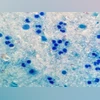)
Chandipura virus (Photo: ANI)
Chandipura virus continues to claim lives in India, with the state of Gujarat being the most affected where 51 people were found to be affected with the virus. While speaking in Rajya Sabha on Tuesday, Health Minister J P Nadda said there were 53 confirmed cases of Chandipura virus in the country.
The Minister claimed that of these 53 cases, 19 people, all of whom belonged to the state of Gujarat, had died. Last month, according to an India Today report, about 38 children were reported to have died because of the virus in the state.
Experts are labelling this the worst Chandipura virus outbreak that India has witnessed in over 20 years, with the majority of victims being children and teenagers.
According to the figures released by the Gujarat government on Tuesday, the number of positive Chandipura virus cases have gone up to 59, with the overall viral encephalitis cases reported at 159 currently, and a death toll of 71.
Active surveillance has been carried out by health rapid response teams, Accredited Social Health Activists (ASHA), and Auxiliary Nurses and Midwives (ANM) in order to promptly identify cases and refer suspected cases to nearby hospitals and medical colleges that provide 24/7 specialist services and ventilator support.
Chandipura virus outbreak in India: Insights
The initial symptoms of Chandipura virus are similar to those of the flu, but they can quickly progress to encephalitis, coma, and death within 24 to 48 hours. The children, younger than 15, are the most powerless. It is unclear precisely how the virus gets into the brain and causes encephalitis. It has been suggested that when an infected insect bites an individual to get their blood meal, they discharge their saliva containing the infection.
The infection then spreads into the individual’s blood and contaminates immune cells called monocytes (a kind of white blood cell), where it imitates, undetected by the immune system. The virus then travels to the central nervous system and breaks through the blood-brain barrier to enter the brain.
The virus is said to release a protein called phosphoprotein inside brain cells within six hours of the victim being affected with it, causing rapid death. There are currently no antiviral drugs to treat individuals contaminated with the Chandipura infection. Furthermore, there is no vaccine.
Chandipura virus: History
Since the infection was first found in 1965, a majority of the cases have been limited to the Indian subcontinent. In any case, the geological circulation of the infection reaches out beyond India. It was identified in sandflies in west Africa in 1991 and 1992, and in hedgehogs in Senegal (1990-96). Antibodies to the Chandipura infection have additionally been tracked down in wild monkeys in Sri Lanka in 1993.
The Chandipura virus is named after the village in Maharashtra, India, where it was first identified in 1965. The first major outbreak didn’t occur until 2003 in Andhra Pradesh, an Indian state in the south, where 329 children tested positive for the virus and 183 died. In addition, an outbreak with 26 cases and a high death rate of 78% was reported in Gujarat in 2005, a state in the northwest.
The recent outbreak, influencing more than 100 individuals in Gujarat, had an especially severe toll for children under 15. Officials in charge of public health have expressed concern regarding the virus’s rapid spread and severity of symptoms.
Chandipura virus outbreak: Transmission
This rod-shaped pathogen belongs to the rabies virus family that causes encephalitis, irritation and swelling in the brain. Furthermore, it is spread primarily by sandflies, yet mosquitoes and ticks can likewise spread it.
The widespread prevalence of Chandipura infection in India is likely connected with climate change and its spread is being accelerated because of warming temperatures, say the experts. As a result of climate change, there has been an increase in the number of bugs-borne diseases in recent years. For instance, this mid year, India reported unlimited cases of mosquito-borne infections, including Zika, dengue and Nipah.
First Published: Aug 08 2024 | 7:03 PM IST


































